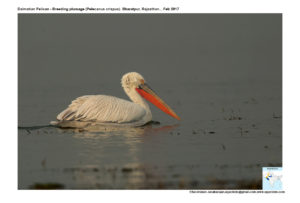
Dalmatian Pelican Pelecanus crispus
Etymology:
- Pelecanus : Greek word pelekan, pelekanos – pelican.
- Crispus : Latin word crispus – curly-headed, wrinkled
Distribution in India: Winter visitor in North West India.
Description:Size of 160-180 cm.It is the largest pelican in India.The breeding adult has upperparts and tail chalky white, feathers of head and neck more or less grizzled because of partially exposed grey bases, hindneck has curly feathers, nuchal feathers noticeably elongated, forming unkempt crest; upperwing largely blackish on bastard wing, primaries and their coverts except lesser ones, secondaries similar but have silvery fringes, these predominating towards wing base, tertials being palest, exposed outer greater secondary-coverts have black shaft and grey to blackish-brown central area, rest of upperwing-coverts chalky white; the largest white feathers of upperparts including upperwing and tail have blackish shafts visible at close range; underwing pale grey over most coverts, axillaries and remiges, the latter noticeably dark at tips, chalky white greater coverts form paler band along center of wing; underparts chalky white, lowermost foreneck and central upper chest have cream-yellow to ochraceous tinge. The non-breeding adult similar but has much-reduced nuchal crest, white of plumage looks dirtier, with slight or no yellowish tinge at base of foreneck; iris whitish to pale sky blue; facial skin yellow-orange in pre-breeding birds, lower part more cream-yellow, narrowly bordered below with blackish-grey skin, in other seasons whitish with slate-grey lower cheeks and anterior lores; in pre-breeding birds, bill mostly blackish grey with partly yellow cutting edges to maxilla, orange nail, pouch bright reddish orange with black stripe sometimes visible below base of mandible, in other seasons bill turns grey rather than blackish, sides more fleshy, gular pouch more orange or yellowish; legs dark to mid grey. Sexes similar, female averages slightly smaller.
Habitat: It is found in rivers, lakes, deltas, estuaries. It winters in jheels and lagoons.
Food Habits: It eats mainly fish. The daily requirement reckoned to be around 1.2 Kg. It forages by swimming along and suddenly plunging head into water to catch fish; in co-operative groups on occasions.
Breeding Habits: They breed in March- June in southeastern Europe to Russia. There are two important prerequisites for pelican breeding, a suitable place to breed, safe from terrestrial predators, and an adequate source of food to keep the colony supplied throughout the breeding season. Typical territorial displays, to ward off intruders or to strengthen the bond in pair formation, include a “Head-up”, with the bill raised skyward and sometimes with the pouch swollen up like a balloon, “Gaping”, “Bill-clapping”, “Bowing”, “Head-wagging” and “Bill-interlocking”, amongst others. The nest-site is selected by the female in most cases. There is a thick twig base, which is sometimes covered with a lining of rice straw and decaying water weeds. It becomes solid with the droppings of the young, but an abandoned nest is usually dismantled by other pelicans or destroyed by the rains, so each year it is necessary to build a new one. They lay a clutch of 1-3 eggs. Incubation is carried out by both sexes and lasts 30-34 days. As in most other Pelecaniformes, there is no brood patch, so the eggs are rested on the feet for incubation, a system also used by the cormorants. Incubation begins with the laying of the first egg and each -parent normally has a stint of about 24 hours. The fledging period is 70-85 days. The parents gradually stop bringing food to the nest, which eventually provokes the chicks into taking to the air for the first time, and ultimately becoming independent .